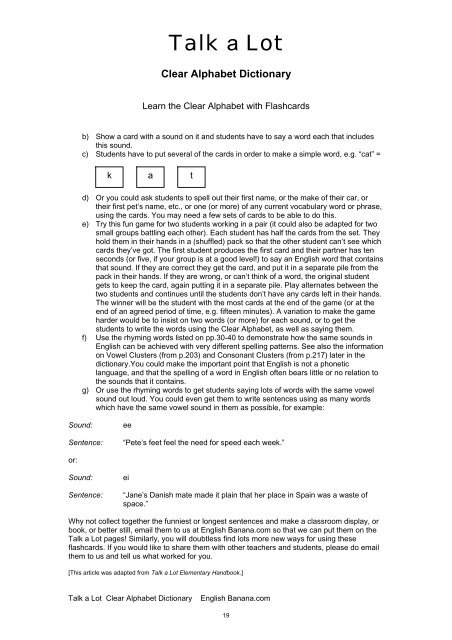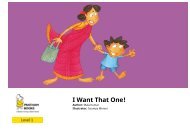14-Clear-Alphabet-Dictionary
Create successful ePaper yourself
Turn your PDF publications into a flip-book with our unique Google optimized e-Paper software.
Talk a Lot<br />
<strong>Clear</strong> <strong>Alphabet</strong> <strong>Dictionary</strong><br />
Learn the <strong>Clear</strong> <strong>Alphabet</strong> with Flashcards<br />
b) Show a card with a sound on it and students have to say a word each that includes<br />
this sound.<br />
c) Students have to put several of the cards in order to make a simple word, e.g. “cat” =<br />
k a t<br />
d) Or you could ask students to spell out their first name, or the make of their car, or<br />
their first pet’s name, etc., or one (or more) of any current vocabulary word or phrase,<br />
using the cards. You may need a few sets of cards to be able to do this.<br />
e) Try this fun game for two students working in a pair (it could also be adapted for two<br />
small groups battling each other). Each student has half the cards from the set. They<br />
hold them in their hands in a (shuffled) pack so that the other student can’t see which<br />
cards they’ve got. The first student produces the first card and their partner has ten<br />
seconds (or five, if your group is at a good level!) to say an English word that contains<br />
that sound. If they are correct they get the card, and put it in a separate pile from the<br />
pack in their hands. If they are wrong, or can’t think of a word, the original student<br />
gets to keep the card, again putting it in a separate pile. Play alternates between the<br />
two students and continues until the students don’t have any cards left in their hands.<br />
The winner will be the student with the most cards at the end of the game (or at the<br />
end of an agreed period of time, e.g. fifteen minutes). A variation to make the game<br />
harder would be to insist on two words (or more) for each sound, or to get the<br />
students to write the words using the <strong>Clear</strong> <strong>Alphabet</strong>, as well as saying them.<br />
f) Use the rhyming words listed on pp.30-40 to demonstrate how the same sounds in<br />
English can be achieved with very different spelling patterns. See also the information<br />
on Vowel Clusters (from p.203) and Consonant Clusters (from p.217) later in the<br />
dictionary.You could make the important point that English is not a phonetic<br />
language, and that the spelling of a word in English often bears little or no relation to<br />
the sounds that it contains.<br />
g) Or use the rhyming words to get students saying lots of words with the same vowel<br />
sound out loud. You could even get them to write sentences using as many words<br />
which have the same vowel sound in them as possible, for example:<br />
Sound:<br />
Sentence:<br />
ee=<br />
“Pete’s feet feel the need for speed each week.”<br />
or:<br />
Sound:<br />
Sentence:<br />
ei=<br />
“Jane’s Danish mate made it plain that her place in Spain was a waste of<br />
space.”<br />
Why not collect together the funniest or longest sentences and make a classroom display, or<br />
book, or better still, email them to us at English Banana.com so that we can put them on the<br />
Talk a Lot pages! Similarly, you will doubtless find lots more new ways for using these<br />
flashcards. If you would like to share them with other teachers and students, please do email<br />
them to us and tell us what worked for you.<br />
[This article was adapted from Talk a Lot Elementary Handbook.]<br />
Talk a Lot <strong>Clear</strong> <strong>Alphabet</strong> <strong>Dictionary</strong><br />
English Banana.com<br />
19



